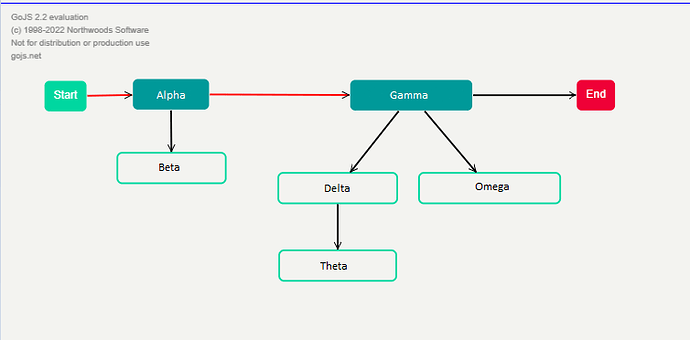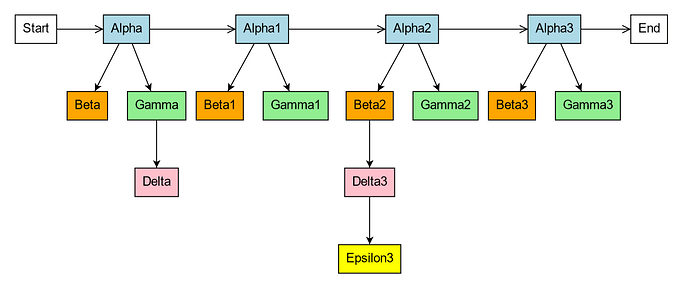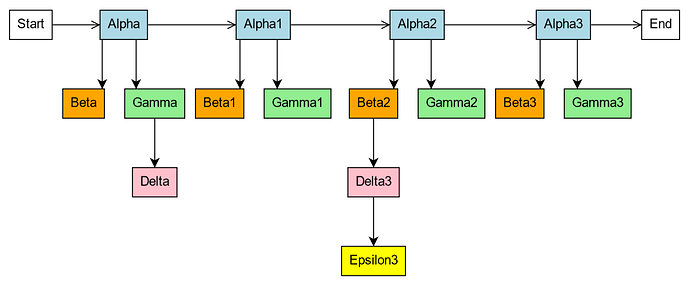What? Changing requirements already?
<!DOCTYPE html>
<html>
<head>
<title>Minimal GoJS Sample</title>
<!-- Copyright 1998-2022 by Northwoods Software Corporation. -->
</head>
<body>
<div id="myDiagramDiv" style="border: solid 1px black; width:100%; height:600px"></div>
<script src="https://unpkg.com/gojs"></script>
<script id="code">
// This custom Link class is smart about computing the link point and direction
class BarLink extends go.Link {
getLinkPoint(node, port, spot, from, ortho, othernode, otherport) {
const r = port.getDocumentBounds();
const op = otherport.getDocumentBounds();
const below = op.centerY > r.centerY;
const y = below ? r.bottom : r.top;
if (op.right < r.left) return new go.Point(r.left, y);
if (op.left > r.right) return new go.Point(r.right, y);
return new go.Point((Math.max(r.left, op.left) + Math.min(r.right, op.right))/2, y);
}
getLinkDirection(node, port, linkpoint, spot, from, ortho, othernode, otherport) {
const p = port.getDocumentPoint(go.Spot.Center);
const op = otherport.getDocumentPoint(go.Spot.Center);
const below = op.y > p.y;
return below ? 90 : 270;
}
}
// end BarLink class
const $ = go.GraphObject.make;
const myDiagram =
$(go.Diagram, "myDiagramDiv",
{
layout:
$(go.TreeLayout,
{
angle: 90,
setsPortSpot: false,
setsChildPortSpot: false,
arrangement: go.TreeLayout.ArrangementHorizontal
}),
"undoManager.isEnabled": true
});
myDiagram.nodeTemplate =
$(go.Node, "Auto",
$(go.Shape,
{ fill: "white" },
new go.Binding("fill", "color")),
$(go.TextBlock,
{ margin: 8, editable: true },
new go.Binding("text").makeTwoWay())
);
myDiagram.linkTemplate =
$(BarLink,
{ routing: go.Link.Orthogonal },
$(go.Shape),
$(go.Shape, { toArrow: "Standard" })
);
myDiagram.linkTemplateMap.add("Seq",
$(go.Link,
{ isLayoutPositioned: false, isTreeLink: false },
$(go.Shape),
$(go.Shape, { toArrow: "OpenTriangle" })
));
myDiagram.model = new go.GraphLinksModel(
[
{ key: 0, text: "Start" },
{ key: 1, text: "Alpha", color: "lightblue" },
{ key: 2, text: "Beta", color: "orange" },
{ key: 3, text: "Gamma", color: "lightgreen" },
{ key: 4, text: "Delta", color: "pink" },
{ key: 11, text: "Alpha1", color: "lightblue" },
{ key: 12, text: "Beta1", color: "orange" },
{ key: 13, text: "Gamma1", color: "lightgreen" },
{ key: 21, text: "Alpha2", color: "lightblue" },
{ key: 22, text: "Beta2", color: "orange" },
{ key: 23, text: "Gamma2", color: "lightgreen" },
{ key: 24, text: "Delta3", color: "pink" },
{ key: 25, text: "Epsilon3", color: "yellow" },
{ key: 31, text: "Alpha3", color: "lightblue" },
{ key: 32, text: "Beta3", color: "orange" },
{ key: 33, text: "Gamma3", color: "lightgreen" },
{ key: 99, text: "End" }
],
[
{ from: 0, to: 1, category: "Seq" },
{ from: 1, to: 2 },
{ from: 1, to: 3 },
{ from: 3, to: 4 },
{ from: 1, to: 11, category: "Seq" },
{ from: 11, to: 12 },
{ from: 11, to: 13 },
{ from: 11, to: 21, category: "Seq" },
{ from: 21, to: 22 },
{ from: 21, to: 23 },
{ from: 22, to: 24 },
{ from: 24, to: 25 },
{ from: 21, to: 31, category: "Seq" },
{ from: 31, to: 32 },
{ from: 31, to: 33 },
{ from: 31, to: 99, category: "Seq" }
]);
</script>
</body>
</html>



